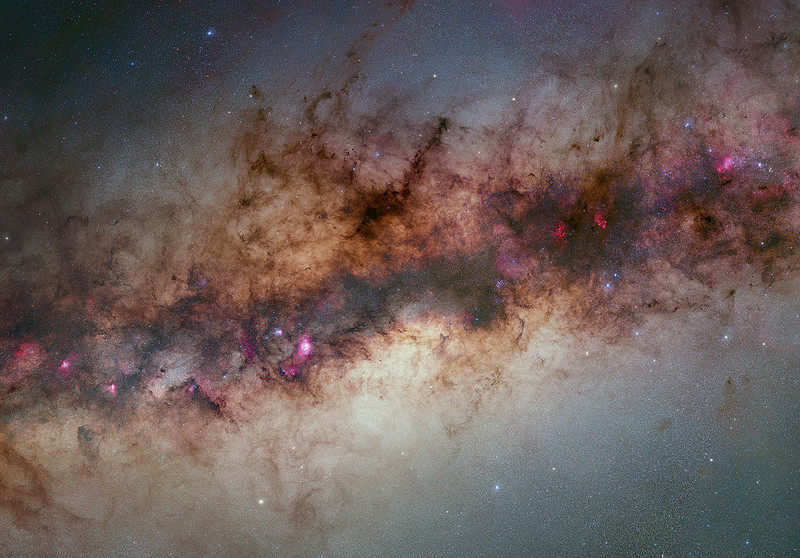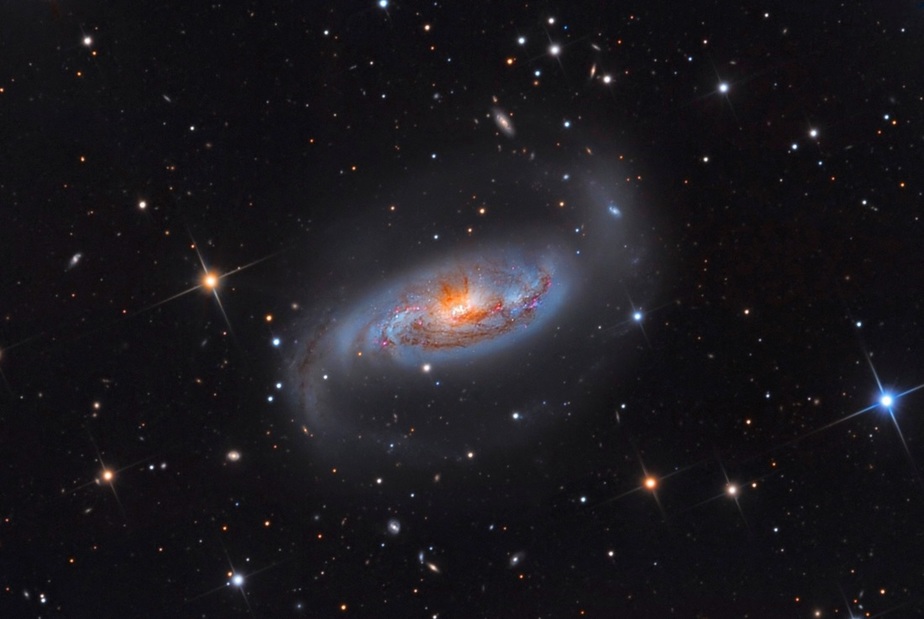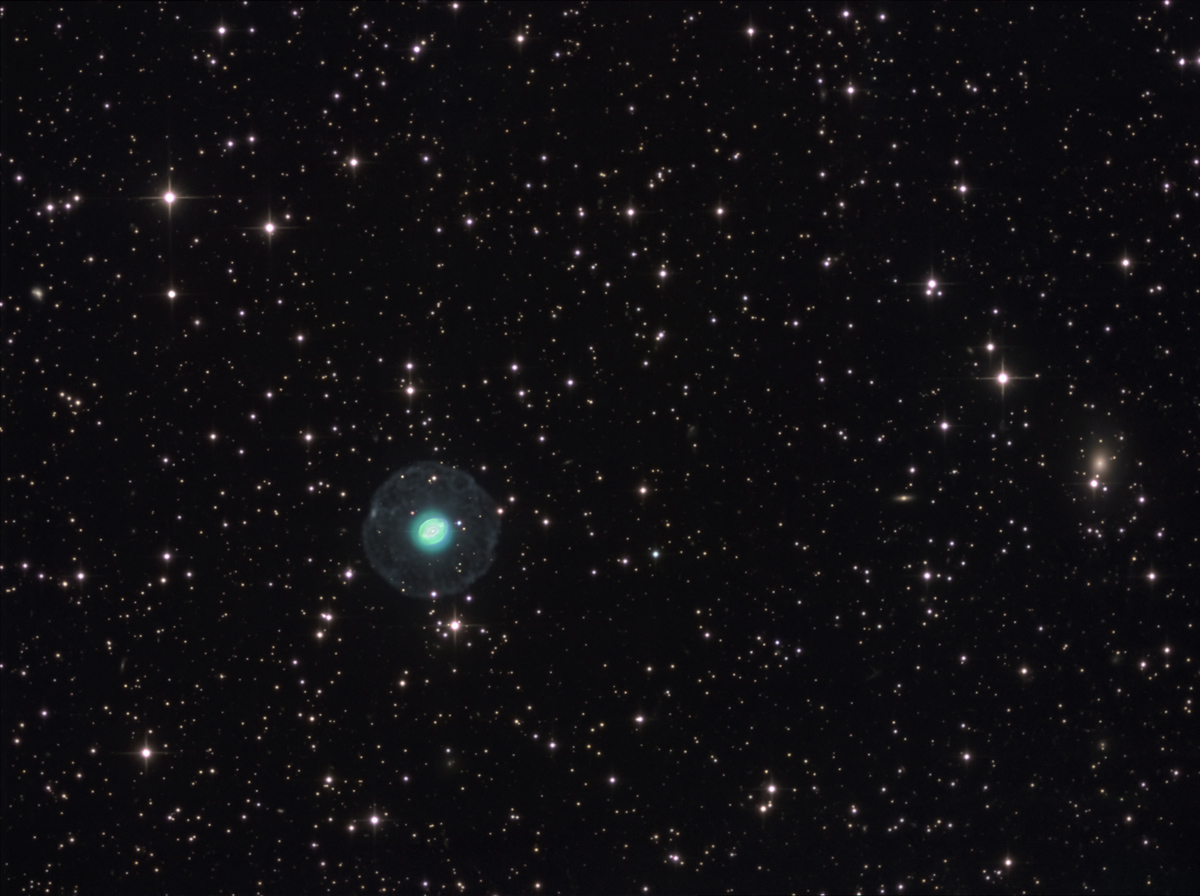Page 2 of 2
Re: Found images: 2016 January
Posted: Sun Jan 17, 2016 7:00 pm
by starsurfer
NGC 6541
http://www.chart32.de/index.php/component/k2/item/178
Copyright: CHART32
Processing: Bernd Flach-Wilken
Re: Found images: 2016 January
Posted: Sun Jan 17, 2016 7:03 pm
by starsurfer
ESO Telescopes Spy a Rare Relic
Posted: Mon Jan 18, 2016 4:38 pm
by bystander
ESO Telescopes Spy a Rare Relic
ESO Picture of the Week | 2016 Jan 18
The Milky Way contains hundreds of billions of stars. However, the star at the centre of this image still manages to be very unusual — no mean feat!
A Brazilian–American team led by Jorge Melendez, from the University of São Paulo used two of ESO’s telescopes in Chile to discover that this star, named 2MASS J18082002–5104378, is a rare relic from the
Milky Way’s formative years. As such, it offers astronomers a precious opportunity to explore the first stars that sprung to life within our galaxy.
2MASS J18082002–5104378 was spotted in 2014 by ESO’s New Technology Telescope (
NTT). Follow-up observations using ESO’s Very Large Telescope (
VLT) discovered that, unlike younger stars such as
the Sun, this star shows an unusually low abundance of what astronomers curiously call
metals — elements heavier than hydrogen and helium. In fact, it is so devoid of these elements that it is known as an UMP, or an ultra metal-poor star — the brightest ever discovered!
Although thought to be ubiquitous in the early Universe, metal-poor stars are now a rare sight within both the Milky Way (
eso1132) and other nearby galaxies. Metals are formed during
nuclear fusion within stars, and are spread throughout the
interstellar medium when these stars grow old and explode. Subsequent generations of stars therefore form from increasingly metal-rich material. Metal-poor stars, however, formed from the unpolluted environment that existed shortly after the
Big Bang. Exploring stars such as 2MASS J18082002–5104378 may unlock secrets about their formation, and show what the Universe was like at the very beginning. ...
2MASS J18082002-5104378: The brightest (V=11.9) ultra metal-poor star - Jorge Melendez
et al
HEIC: Rebel Rebel (NGC 5408)
Posted: Mon Jan 18, 2016 5:03 pm
by bystander
Rebel Rebel (NGC 5408)
ESA Hubble Picture of the Week | 2016 Jan 18
Most galaxies possess a majestic spiral or elliptical structure. About a quarter of galaxies, though, defy such conventional, rounded aesthetics, instead sporting a messy, indefinable shape. Known as
irregular galaxies, this group includes
NGC 5408, the galaxy that has been snapped here by the NASA/ESA Hubble Space Telescope.
English polymath
John Herschel recorded the existence of NGC 5408 in June 1834. Astronomers had long mistaken NGC 5408 for a
planetary nebula, an expelled cloud of material from an aging star. Instead, bucking labels, NGC 5408 turned out to be an entire galaxy, located about 16 million light-years from Earth in the constellation of
Centaurus (
The Centaur).
In yet another sign of NGC 5408 breaking convention, the galaxy is associated with an object known as an
ultraluminous X-ray source, dubbed
NGC 5408 X-1, one of the best studied of its class. These rare objects beam out prodigious amounts of energetic X-rays. Astrophysicists believe these sources to be strong candidates for
intermediate-mass black holes. ...
Re: Found images: 2016 January
Posted: Tue Jan 19, 2016 4:57 pm
by starsurfer
M46 and NGC 2438
http://www.astropilar.com.ar/nebulosas/NGC2438_1.html
Copyright: Aldo Mottino, Carlos Colazo and Ezequiel Bellocchio
M46 is the open cluster and NGC 2438 is the planetary nebula. Despite appearances, the two are physically unrelated.
Re: Found images: 2016 January
Posted: Tue Jan 19, 2016 4:58 pm
by starsurfer
Re: Found images: 2016 January
Posted: Wed Jan 20, 2016 4:31 pm
by starsurfer
Re: Found images: 2016 January
Posted: Thu Jan 21, 2016 5:36 pm
by starsurfer
ESO: Our Nearest Star System Observed Live
Posted: Mon Jan 25, 2016 5:21 pm
by bystander
Our Nearest Star System Observed Live
ESO Picture of the Week | 2016 Jan 25
In the sky above ESO's
La Silla Observatory, the
Southern Cross is clearly visible just to the right of the dome of the
Danish 1.54-metre telescope, and to the lower right of the image, two stars sparkle in the amazingly dark sky. From right to left, these are Alpha and
Beta Centauri.
Alpha Centauri is a multiple star, the nearest star system to Earth.
A little closer to Earth than the bright components of Alpha Centauri, and invisible to the naked eye, is
Proxima Centauri, the third star belonging to this multiple star system. It is our closest neighbour, at a distance of just 4.2 light-years. Previous observations have provided tantalising, but subtle, hints of a small companion orbiting this red dwarf star. An observing campaign that started in January 2016 will make a more sensitive search for the telltale wobbles in the dwarf star’s orbital motion that might reveal the presence of an Earth-like orbiting planet: the
Pale Red Dot campaign. ...
http://asterisk.apod.com/viewtopic.php?t=35562
HEIC: A Misbehaving Spiral (LO95 0313-192)
Posted: Mon Jan 25, 2016 5:38 pm
by bystander
A Misbehaving Spiral (LO95 0313-192)
ESA Hubble Picture of the Week | 2016 Jan 25
Despite its unassuming appearance, the edge-on spiral galaxy captured in the left half of this NASA/ESA Hubble Space Telescope image is actually quite remarkable.
Located about one billion light-years away in the constellation of
Eridanus, this striking galaxy — known as
LO95 0313-192 — has a spiral shape similar to that of the Milky Way. It has a large central bulge, and arms speckled with brightly glowing gas mottled by thick lanes of dark dust. Its companion, sitting pretty in the right of the frame, is known rather unpoetically as [LOY2001] J031549.8-190623.
Jets, outbursts of superheated gas moving at close to the speed of light, have long been associated with the cores of giant elliptical galaxies, and galaxies in the process of merging. However, in an unexpected discovery, astronomers found LO95 0313-192 to have intense radio jets spewing out from its centre! The galaxy appears to have two more regions that are also strongly emitting in the radio part of the spectrum, making it even rarer still.
The discovery of these giant jets in 2003 — not visible in this image, but indicated in
this earlier Hubble composite — has been followed by the unearthing of a further three spiral galaxies containing radio-emitting jets in recent years. This growing class of unusual spirals continues to raise significant questions about how jets are produced within galaxies, and how they are thrown out into the cosmos.
Re: Found images: 2016 January
Posted: Mon Jan 25, 2016 6:33 pm
by starsurfer
LBN 437
http://www.astrosurf.com/comolli/d195.htm
Copyright: Lorenzo Comolli and Edoardo Radice
Re: Found images: 2016 January
Posted: Mon Jan 25, 2016 6:37 pm
by starsurfer
NGC 6826
http://www.capella-observatory.com/Imag ... GC6826.htm
Copyright: Stefan Binnewies and Josef Pöpsel
Re: Found images: 2016 January
Posted: Mon Jan 25, 2016 6:49 pm
by starsurfer
SMC
http://www.atacama-photographic-observatory.com
Copyright: Thierry Demange, Richard Galli and Thomas Petit
Re: Found images: 2016 January
Posted: Mon Jan 25, 2016 6:52 pm
by starsurfer
Wray 17-31
http://www.pbase.com/strongmanmike2002/ ... 31_in_vela
Copyright: Michael Sidonio
This planetary nebula is also catalogued as VBRC 2.
Re: Found images: 2016 January
Posted: Tue Jan 26, 2016 6:25 pm
by starsurfer
Re: Found images: 2016 January
Posted: Wed Jan 27, 2016 6:25 pm
by starsurfer
Re: Found images: 2016 January
Posted: Fri Jan 29, 2016 9:20 am
by starsurfer
Sh2-86
http://www.astrobin.com/222229/D/
Copyright: Enrico Scheibel
Re: Found images: 2016 January
Posted: Fri Jan 29, 2016 9:25 am
by starsurfer
Re: Found images: 2016 January
Posted: Fri Jan 29, 2016 9:28 am
by starsurfer
Re: Found images: 2016 January
Posted: Fri Jan 29, 2016 9:34 am
by starsurfer
Re: Found images: 2016 January
Posted: Fri Jan 29, 2016 5:09 pm
by cazza132
Our galactic center.
 Galactic Core - 160130
Galactic Core - 160130 by
Troy Casswell, on Flickr
ESO: An Often Ignored Beauty (NGC 986)
Posted: Mon Feb 01, 2016 2:37 pm
by bystander
An Often Ignored Beauty (NGC 986)
ESO Picture of the Week | VLT | FORS | 2016 Feb 01
This picture of the week shows the spiral galaxy
NGC 986 in the constellation of
Fornax (
The Furnace). The galaxy, which was discovered in 1826 by the Scottish astronomer
James Dunlop, is not often imaged due to its proximity to the famous and rich
Fornax Cluster of galaxies. Which is a shame, as this galaxy is not only a great scientific object, but also very pretty.
The galaxy is about 56 million light-years away and seen almost perfectly from the top, or — as astronomers say — face-on. This allows us to see the two main spiral arms and also a central bar-shaped structure, composed of stars and dust, which makes it a
barred spiral galaxy.
Astronomical surveys have shown that about two thirds of all spiral galaxies contain a bar, including the Milky Way. This makes NGC 986 the perfect place to study the structure of galaxies and find out more about our own home galaxy, which is difficult to study from within.
This view from the
FORS instrument on ESO’s
Very Large Telescope at the Paranal Observatory in northern Chile comes from the
ESO Cosmic Gems programme, an outreach initiative to produce images of interesting, intriguing or visually attractive objects using ESO telescopes, for the purposes of education and public outreach. The programme makes use of telescope time that cannot be used for science observations. All data collected may also be suitable for scientific purposes, and are made available to astronomers through
ESO’s science archive.
HEIC: One from Many (NGC 1487)
Posted: Mon Feb 01, 2016 2:55 pm
by bystander
One from Many (NGC 1487)
ESA Hubble Picture of the Week | 2016 Feb 01
This image, taken by the NASA/ESA Hubble Space Telescope, shows a
peculiar galaxy known as
NGC 1487, lying about 30 million light-years away in the southern constellation of
Eridanus.
Rather than viewing a celestial object, it is actually better to think of this as an event. Here, we are witnessing two or more galaxies in the act of
merging together to form a single new galaxy. Each progenitor has lost almost all traces of its original appearance, as stars and gas have been thrown hither and thither by gravity in an elaborate cosmic whirl.
Unless one is very much bigger than the other, galaxies are always disrupted by the violence of the merging process. As a result, it is very difficult to determine precisely what the original galaxies looked like and, indeed, how many of them there were. In this case, it is possible that we are seeing the merger of several
dwarf galaxies that were previously clumped together in a small group.
Although older yellow and red stars can be seen in the outer regions of the new galaxy, its appearance is dominated by large areas of bright blue stars, illuminating the patches of gas that gave them life. This burst of
star formation may well have been triggered by the merger.
Re: Found images: 2016 January
Posted: Mon Feb 01, 2016 6:23 pm
by starsurfer
Cat's Eye Nebula (NGC 6543)
http://www.capella-observatory.com/Imag ... 9970mm.htm
Copyright: Makis Palaiologou, Stefan Binnewies and Josef Pöpsel
Re: Found images: 2016 January
Posted: Tue Feb 02, 2016 9:22 am
by starsurfer
Vela Supernova Remnant
http://www.glitteringlights.com/Images/ ... pqWFzmt/X3
Copyright: Marco Lorenzi
A small part of the supernova remnant Puppis A can be seen near the top right corner.




